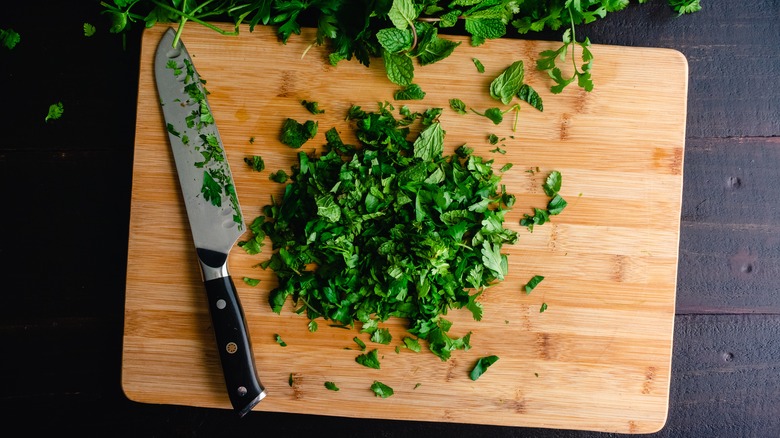The Tell-Tale Sign It's Time To Replace Your Old Cutting Boards
In commercial kitchens, food safety is drilled into the kitchen staff, who typically has to complete some sort of food handling class each year to stay on the job. All the same food safety rules that every chef and line cook know by heart are true in home kitchens, too, even though most home chefs aren't usually trained in food handling.
Some obvious rules include hand washing and keeping perishable items cold in the refrigerator or freezer. But there are many other ways to accidentally spread contaminants in your kitchen that you may not be aware of. One of the most common culprits of food-borne illness is cross-contamination. The most obvious example is using a cutting board to cut raw meat and then using it again without washing and sanitizing it to cut something else served raw, like salad or vegetables — don't do it. Cross-contamination can pop up in a lot of other sneaky ways, too. Keep your work surfaces clean and sanitized at all times, especially cutting boards, and be sure to replace them if they start to show a lot of wear and tear, as they can spread germs that can make you sick. But how do you know when to say goodbye to your cutting boards?
Plastic boards
Cutting boards can be made of wood, plastic, and even rubber or glass. The most common material for home cutting boards is usually high-density plastic because they are lightweight, inexpensive, and easy to clean. However, plenty of people still cut on wooden boards as well.
Plastic cutting boards can take a lot of abuse, including the dishwasher, but they aren't designed to live forever. Over time, your plastic cutting board can warp and crack from the high heat in the dishwasher, which can prevent them from lying flat on a countertop for cutting. Warped boards are not only annoying but also dangerous because you won't have a flat surface to work with, and you'll have less control over whatever you're cutting. Also, if your cutting board develops deep cuts or grooves where your knife naturally slices again and again, it's time to replace it because even if you give the board a deep scrub after you use it, those crevices can hang on to odors and harmful bacteria. Express recommends replacing your plastic cutting boards yearly, which is a good idea if you use them several times a week. If you don't use your cutting boards all the time, you don't need to toss them out every year; keep an eye on their condition. If you see any especially pronounced grooves or scratches, or if boards become misshapen, it's time to let them go.
Wooden boards
The same replacement rules mainly apply to wooden cutting boards. Although their material is a little more forgiving and self-healing from knife cuts, wooden boards will hold bacteria in their grooves just like plastic. Wooden boards are also more porous, so they can hold a lot of germs unless you clean them properly by hand, as they aren't dishwasher safe. Try using a mixture of lemon and coarse salt to clean after your subsequent use.
The one big difference between plastic and wooden cutting boards is that the wooden ones don't necessarily have to be replaced. If they're flat and crack-free but have lots of deep cuts and scratches, try sanding down the surfaces instead of throwing them away. Restoring is more high maintenance than buying a new, inexpensive plastic board, but it will also stretch the life of your wooden boards out over decades. Plus, if you get good at restoring, you can collect vintage cutting boards from flea markets and estate sales. For day-to-day cutting, however, it's good to have a few plastic boards to run through the dishwasher and save your wooden boards for serving things like cheese and charcuterie.


